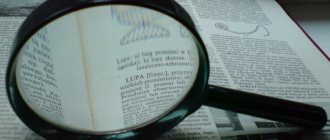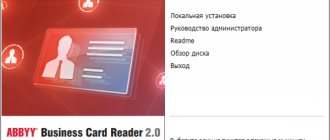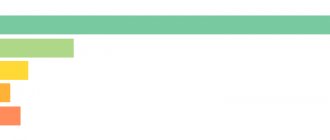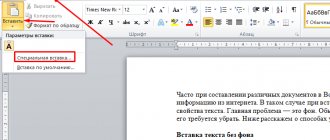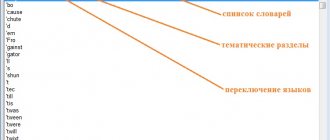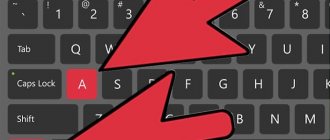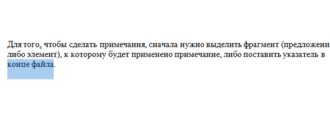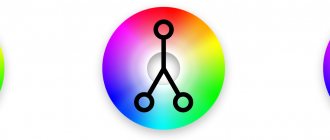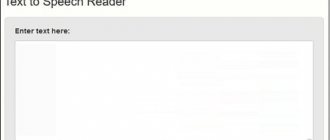Converting text into digital format is a fairly common task for those who work with documents. The Abbyy Finereader program will help you save a lot of time by automatically translating inscriptions from raster images or “readers” into editable text.
In this article we will look at how to use Abbyy Finereader for text recognition.
How to recognize text from a picture using Abbyy Finereader
In order to recognize text on a raster image, simply load it into the program, and Abbyy Finereader will automatically recognize the text. All you have to do is edit it, highlight what you need and save it in the required format or copy it into a text editor.
You can recognize text directly from a connected scanner.
Read more on our website.
How to recognize text from a picture using Abbyy Finereader
How to use
To make it easier for you to understand installation and use, we will briefly review these operations.
Download and Install
First, go to the end of the page and download the torrent file of the program. Download the archive along with the installer and crack file, then extract them to your hard drive. To install the software, follow a series of simple steps:
- Run the installer and follow the initial steps according to the instructions.
- When selecting a directory, leave the default settings!
- Wait for the procedure to complete and close the installer.
If you were previously looking for someone who could tell you the serial key, or were thinking about buying a license, now you just need to follow the instructions:
- After installation, do not launch the application. Copy the activator to the root directory.
- Launch the crack using administrator rights.
- Click the Patch button and wait a while.
- After the successful activation message, close the application.
Along with this look: Microsoft Visio 2010 Russian version
Now you have a cracked ABBYY FineReader 12 Pro on your computer, which will no longer require you to enter a license code.
Operating instructions
Let's figure out how to use recognition software:
- Select a source. You can load a saved image or connect a scanner. In the first case, the quality will be higher.
- Perform recognition of the entire document or a selected area. The program will find pictures, text and other elements.
- Check what needs to be edited or deleted using the built-in tools.
- Convert the final result into the desired format. This can be DOCX, XLS, PPTX, PDF, TXT, FB2, BMP, JPEG and other resolutions depending on the recognized content.
How to create a PDF and FB2 document using Abbyy Finereader
The Abbyy Finereader program allows you to convert images into the universal PDF format and FB2 format for reading on e-readers and tablets.
The process for creating such documents is similar.
1. In the main menu of the program, select the E-Book section and press FB2. Select the source document type—scan, document, or photo.
2. Find and open the required document. It will load into the program page by page (this may take some time).
3. When the recognition process is completed, the program will prompt you to select a format for saving. Select FB2. If necessary, go to “Options” and enter additional information (author, title, keywords, description).
After saving, you can remain in text editing mode and convert it to Word or PDF format.
How it works: FineReader
Although the advances made to artificial intelligence (AI) over the past 50 years have not brought smart machines one iota closer to human cognitive capabilities, it would be unfair to completely deny advances in this direction. The most obvious and striking example is chess (not to mention simpler games). A computer cannot yet imitate our thinking, but it is quite capable of compensating for this gap with a large amount of specialized memory and search speed. Vladimir Kramnik described the game of the Deep Fritz program that defeated him in 2006 as “inhuman” in the sense that it often contradicted the established (human) rules of strategy and tactics.
And just over a year ago, another brainchild of IBM, which at one time laid the foundation for the triumphant chess victories of computers (the famous Deep Blue), called Watson, made a new breakthrough, defeating two champions of the popular American quiz Jeopardy by a wide margin. It is significant, however, that although Watson independently voiced the answers, the questions were still transmitted to him in text form. This suggests that successes in many areas of AI application - speech and image recognition, machine translation - are quite modest, although this does not prevent us from using them in practice today. The greatest successes, perhaps, are demonstrated by optical character recognition systems (OCR, Optical Character Recognition), with which almost all PC users are probably familiar in one way or another. Moreover, Russian developments in this area occupy a worthy place in the world - I mean ABBYY FineReader.
A little history
The current version of ABBYY FineReader is number 11, i.e. the application has gone through quite a long development path, and even the history of this process is of some interest. Without pretending to be an exhaustive chronicle, I will give only the main milestones over the last decade, during which I more or less followed FineReader:
| Year | Version | Main features |
| 2003 | 7.0 | Increase in recognition accuracy up to 25%. This was most reflected in tables, especially complex ones, with colored cells, hidden dividers, etc. |
| 2005 | 8.0 | Further optimization of recognition algorithms, primarily aimed at working not with scanned documents, but with digital photographs. For this purpose, additional functions for preparing originals have appeared (eliminating distortions, aligning lines, etc.). |
| 2007 | 9.0 | The emergence of ADRT technology, which takes into account the logical structure of the entire processed (multi-page) document and is able to highlight repeating elements (headers and footers), connect “flowing” objects (tables), etc. |
| 2009 | 10.0 | Further improvement of ADRT and recognition algorithms, increasing the processing accuracy of low-resolution originals by up to 30%. |
| 2011 | 11.0 | The main attention is paid to the speed of the program. “Second Coming” of the black and white mode, which on good quality originals gives an additional acceleration of up to 30%. |
Naturally, during the same time, FineReader expanded support for document formats, improved built-in tools and interface, improved reconstruction of the structure of originals, etc. However, the highlighted points are directly related to OCR technologies and demonstrate well the spasmodic development process characteristic of complex high-tech systems when after the next “breakthrough” there follows a certain period of “quiet”, necessary for improving new algorithms. They represent the main value of any OCR program, and therefore any detailed information about them rarely reaches users. However, ABBYY kindly agreed to lift the veil of secrecy, and today we have the opportunity to look into the holy of holies of FineReader.
Basic principles
So, since OCR belongs to the field of AI, it is logical that developers strive to at least to some extent imitate the activity of our brain. Of course, the structure of our visual system is incredibly complex, but the basic “large-block” principles of its functioning have been sufficiently studied; usually there are three of them:
- Integrity
- an object is considered as a collection of its parts and (for visual images) spatial relationships between them. In turn, the parts receive interpretation only as part of the entire object. This principle helps to build and clarify hypotheses, quickly eliminating unlikely ones. - Purposefulness
- since any interpretation of data pursues a specific goal, recognition is a process of putting forward hypotheses about an object and purposefully testing them. A system operating in accordance with this principle will not only use computing power more economically, but also make fewer mistakes. - Adaptability
- the system stores information accumulated during operation and reuses it, i.e. it learns itself. This principle allows you to create and accumulate new knowledge and avoid repeatedly solving the same problems.
FineReader is the only OCR system in the world that operates in accordance with the principles described above at all stages of document processing. The corresponding technology is called IPA
- according to the first letters of English terms. For example, according to the principle of integrity, a fragment of an image will be interpreted as a symbol only if it contains all the structural parts of similar objects, and those that are in certain relationships. This helps to replace the search of a large number of standards (in search of a more or less suitable one) with a targeted test of a reasonable number of hypotheses, relying on previously accumulated information about the possible outlines of a character in a recognized document.
However, IPA principles apply when analyzing not only fragments corresponding to (presumably) individual characters, but also the entire source image of the page. Most OCR systems are based on recognizing the hierarchical structure of a document, i.e. the page is divided into basic structural elements such as tables, images, blocks of text, which, in turn, are divided into other characteristic objects - cells, paragraphs - and so on , down to individual characters.
Such an analysis can be carried out in two main ways: top-down, i.e., from constituent elements to individual characters, or, conversely, bottom-up. Most often one of them is used, but ABBYY has developed a special MDA
(multilevel document analysis), which combines both. Briefly, it looks like this: the structure of the page is analyzed using a top-down method, and the reconstruction of the electronic document after recognition is completed occurs from the bottom up, but at all levels there is an additional feedback mechanism. As a result, the likelihood of gross errors associated with incorrect recognition of high-level objects is sharply reduced.
ADRT
Historically, OCR systems have evolved from recognizing individual characters. This task is still the most important and most difficult; the most complex algorithms are associated with it. However, it soon became clear that higher-level information (for example, about the language of the document and the correct spelling of recognized words) could help in solving this problem - this is how contextual and dictionary checks appeared. Then the desire to preserve formatting and recreate the physical structure (i.e., the relative positions of various objects) of a document led to the need for detailed analysis of an entire page. It is clear that this also significantly affects the overall quality of recognition, since it helps to correctly process multi-column layout, tables and other methods of “non-linear” text arrangement.
Most modern OCR operates precisely at these three levels - characters, words, pages - practicing, as already mentioned, top-down or bottom-up approaches. However, ABBYY, in accordance with the principles of IPA, introduced another level into FineReader - the entire multi-page document. First of all, this was needed to correctly reproduce the logical structure, which in modern documents is becoming more and more complex. But there are additional bonuses: increased accuracy and faster processing of repeating objects, more correct identification (and therefore recognition) of objects “flowing” from page to page.
ADRT was developed for.
(Adaptive Document Recognition Technology) is a technology for document analysis and synthesis at the logical level. Ultimately, it helps make the result of FineReader work as similar as possible to the original. To do this, the image of the entire document is analyzed, and the recognized words are combined into groups (clusters) depending on the style, environment and location on the page. In this way, the program seems to see the “logic” of the document markup and can subsequently unify the design of the result.
Thanks to ADRT, FineReader, starting with version 9.0, has learned to detect, recognize and reproduce the following structural parts and document formatting elements:
- main text;
- headers and footers;
- page numbers;
- headers of the same level;
- table of contents;
- text inserts;
- captions for drawings;
- tables;
- footnotes;
- signature/seal zones;
- fonts and styles.
Recognition process
In accordance with the MDA algorithm, the actual recognition begins from top to bottom, from the page level. It is clear that the more wrong decisions are made in the early stages of this process, the more there will be in the subsequent ones. This is why recognition accuracy depends so much on the quality of the originals, but their pre-processing algorithms can also have a significant impact. Thus, as the popularity of color documents grew in FineReader, an adaptive binarization ( AB)
). If you scan a document immediately in black and white mode, where there are watermarks or the text is located on a textured or color substrate, then “garbage” will invariably appear on the image, which will then be quite difficult to separate from the “useful” image (since the original information about him is already lost). That is why FineReader prefers to work with color or grayscale images, independently converting them into black and white (this process is called binarization). But that's not all. Since the colors of the text and background can vary within the page and even within individual lines, AB identifies words with more or less the same characteristics and selects the optimal binarization parameters for each from the point of view of recognition quality. This is precisely the adaptivity of the algorithm, which is therefore an example of the use of feedback in MDA. It is clear that the effectiveness of AB strongly depends on the design of the source documents - on the ABBYY test base, this algorithm provided an increase in recognition accuracy by 14.5%.
But the most interesting, of course, begins when the recognition process descends to the lowest levels. The so-called linear division procedure splits lines into words and words into individual letters; then, in accordance with the IPA principle, it generates a set of hypotheses (i.e., possible options for what kind of symbol this is, what symbols the word is divided into, etc.) and, providing each with a probability estimate, passes it to the input of the character recognition mechanism. The latter consists of a number of so-called classifiers
, each of which also generates a number of hypotheses ranked by their expected degree of probability. The most important characteristic of any classifier is the average position of the correct hypothesis. It is clear that the higher it is, the less work for subsequent algorithms - for example, dictionary checking. But for sufficiently well-established classifiers, characteristics such as recognition accuracy based on the first three hypotheses or only on the first one are most often assessed - that is, roughly speaking, the ability to guess the correct answer in three or one attempt. ABBYY uses the following types of classifiers in its systems: raster, feature, feature differential, contour, structural and structural differential - which are grouped at two logical levels.
Operating principle of the Republic of Kazakhstan
, or raster classifier, is based on a pixel-by-pixel comparison of a character image with standards. The latter are formed as a result of averaging images from the training set and reduced to a certain standard form; Accordingly, the size, thickness of elements, and slope are also pre-normalized for the recognized image. This classifier is characterized by ease of implementation, speed of operation and resistance to image defects, but provides relatively low accuracy and that is why it is used at the first stage - to quickly generate a list of hypotheses.
Feature classifier ( PC
), as its name suggests, is based on the presence of signs of a particular symbol in the image. If there are N such features in total, then each hypothesis can be represented by a point in N-dimensional space; accordingly, the accuracy of the hypothesis will be assessed by the distance from it to the point corresponding to the standard (which is also developed on the training set). It is clear that the types and number of features largely determine the quality of recognition, so there are usually quite a lot of them. This classifier is also relatively fast and simple, but is not very robust to various image defects. In addition, the PC does not operate with the original image, but with a certain model, an abstraction, i.e. it does not take into account some of the information: say, the very fact of the presence of some important elements does not say anything about their relative position. For this reason, the PC is used not instead of, but together with the RK.
Contour classifier ( CC
) is a special case of PC and differs in that it analyzes the contours of the intended character extracted from the original image. In general, its accuracy is lower than that of a full-fledged PC.
Feature-based differential classifier ( MAC
) is also similar to PC, but is used solely to distinguish between similar objects such as "m" and "rn". Accordingly, it analyzes only those areas where differences are hidden, and it receives as input not only the original images, but also hypotheses formed at the early stages of recognition. The principle of its operation, however, is somewhat different from a PC. At the training stage, two “clouds” (groups of points) of possible values for each of the two options are formed in N-dimensional space, then a hyperplane is constructed that separates the “clouds” from each other and is approximately equidistant from them. The recognition result depends on which half-space the point corresponding to the original image falls into.
MPC itself does not put forward hypotheses, but only refines existing ones (the list of which is generally sorted using the bubble method), so that a direct assessment of its effectiveness is not carried out, but indirectly it is equated to the characteristics of the entire first level of OCR recognition. However, it is clear that it depends on the correctness of the selected features and the representativeness of the sample of standards, ensuring which is a rather labor-intensive task.
Structural-differential classifier ( SDK
) was originally used for processing handwritten texts. Its task is to distinguish between similar objects such as “C” and “G”. Thus, SDK is based on features characteristic of each pair of characters, its learning process is even more complex than that of MDC, and its operating speed is lower than that of all previous classifiers.
Structural classifier ( SC
) is a source of pride for ABBYY; it was originally developed for recognizing so-called handwritten text, that is, when a person writes in “printed” letters, but was later used for printing. It is used at the final stages of recognition and comes into effect quite rarely, namely, only when at least two hypotheses with sufficiently high probabilities reach it.
The qualitative characteristics of all classifiers are collected in the following table. They, however, only allow one to evaluate the effectiveness of the algorithms relative to each other, since they are not absolute, but are obtained based on the processing of a specific test sample. It may seem that at the last stages of recognition the struggle is literally for a fraction of a percent, but in fact, each classifier makes a significant contribution to increasing the recognition accuracy - for example, the SC reduces the number of errors by a noticeable 20%.
| RK | PC | QC | MPC* | KFOR** | SK** | |
| Accuracy for the first three options, % | 99,29 | 99,81 | 99,30 | 99,87 | 99,88 | — |
| Accuracy according to the first option, % | 97,57 | 99,13 | 95,10 | 99,26 | 99,69 | 99,73 |
* assessment of the entire first level of the ABBYY OCR algorithm ** assessment for the entire algorithm after adding the appropriate classifier
It is curious, however, that, despite the fairly high accuracy, the recognition algorithm itself does not make the final decision. In accordance with the MDA principle, hypotheses are put forward at each logical level, and their number can grow exponentially. Accordingly, sequential testing of all hypotheses is unlikely to be effective, and therefore ABBYY OCR systems use a method for structuring hypotheses, i.e., assigning them to one or another model. There are a couple of dozen of the latter, here are just a few of their types: dictionary word, non-dictionary word, Arabic numerals, Roman numerals, URL, regular expression - and each can include many specific models (for example, a word in one of the known languages, Latin, Cyrillic etc.).
All final actions are carried out with hypotheses built using models. For example, contextual checking will determine the language of the document and immediately significantly reduce the likelihood of models using incorrect alphabets, and dictionary checking will compensate for errors in uncertain recognition of certain characters: for example, the word “turn” is present in the English dictionary - unlike “tum” (in in any case, it is not among the popular ones). Although the priority of the dictionary is higher than that of any classifier, it is not necessarily the last resort, and in general does not stop further checks: firstly, as mentioned above, there is a model of a non-dictionary word, and secondly, the special organization of dictionaries allows with a high percentage probabilities to guess whether some unknown word can belong to a particular language. However, dictionary checking (and the completeness of dictionaries) has a significant impact on the recognition result, and in ABBYY’s own tests it reduces the number of errors by almost half.
Not only OCR
Printed documents are far from the only ones of interest from the point of view of their digitization and automatic processing. Quite often you have to work with forms, i.e. documents with predefined and fixed fields that are filled out manually, but relatively accurately (so-called hand-printed characters) - various questionnaires can serve as an example. The technology for their processing has a separate name - ICR
(intelligent character recognition) - and differs quite significantly from OCR. So, since in this case the task is not to recreate the entire document, but to extract specific data from it, it breaks down into two main subtasks: finding the necessary fields and actually recognizing their contents.
This is a fairly specific area, and ABBYY offers a completely separate software product, ABBYY FlexiCapture, for it. It is intended for creating automated and semi-automated systems, involves customization for specific types of documents for which special templates are created, can intelligently find various fields on pages and verify data in them, etc. However, at the very core are character recognition algorithms similar to those , which are used in FineReader, and the general scheme is very similar:
However, there is still an important difference: the structural classifier is an obligatory participant in the process - this is due to the specifics of hand-printed symbols. In addition, ICR involves a large number of specific additional checks: for example, whether a character is crossed out, or whether the recognized characters actually form a date.
Features of text editing in Abbyy Finereader
There are several options for text that Abbyy Finereader recognizes.
In the original document, save the pictures and footers so that they are transferred to the new document.
Analyze the document to know what errors and problems may arise during the conversion process.
Edit the page image. Options for cropping, photo correction, and changing resolution are available.
We recommend reading: The best programs for text recognition
So we told you how to use Abbyy Finereader. It has quite broad capabilities for editing and converting texts. Let this program help you create any documents you need.
We are glad that we were able to help you solve the problem. Add the Lumpics.ru website to your bookmarks and we will be useful to you. Thank the author and share the article on social networks.
Describe what didn't work for you. Our specialists will try to answer as quickly as possible.
Download
By clicking on the button below, you will download the torrent file for downloading the ABBYY FineReader 12 installer along with the activator. After using the crack you will receive a perpetual license for the software.
Also watching: SMART Notebook 19.1
| Version: | 12.0.101.264 |
| Developer: | ABBYY Software |
| Release year: | 2014 |
| Name: | ABBYY FineReader 12 Professional Edition |
| Platform: | Microsoft Windows XP, Vista, 7, 8.1, 10 |
| Language: | Russian English |
| License: | Paid (can be activated with a crack or license key) |
| Archive password: | bestsoft.club |


